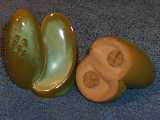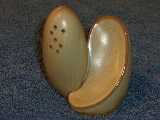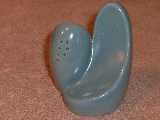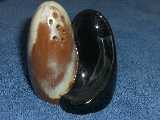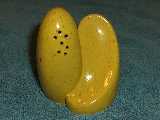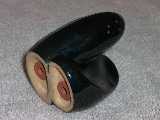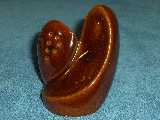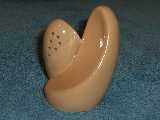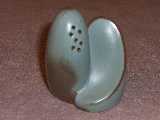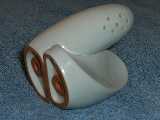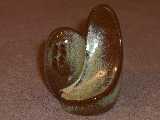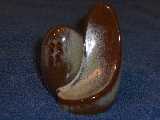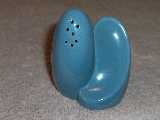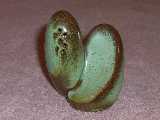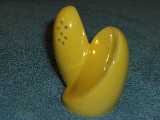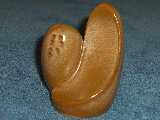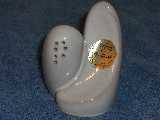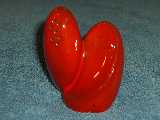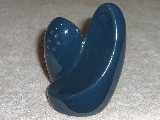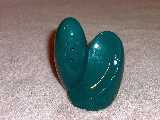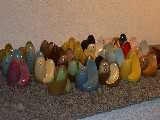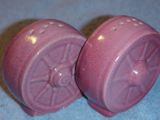

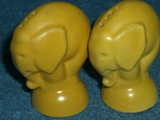
Lazybones Shaker #4H: 1953-2004
The Lazybones pattern shaker is the only dinnerware shaker Frankoma produced with both the salt and pepper molded as one piece. One other Frankoma shaker, the Turner Turnpike commemorative set introduced in 1953 also shares this feature. John Frank probably produced the two designs in the same time frame. The Lazybones shaker is a significant marker design. Lazybones arrived on the dinnerware scene in 1953, the last year for Ada clay production.
Frankoma introduced Lazybones glazed with both the perennial favorites prairie green and desert gold and in the new-for-1953 glaze clay blue. Also the “S” pattern pour holes are from the start in the double-diamond design. The development of the double-diamond started about 1950 and became company policy by the end of 1952. The ardent collector can with some luck find this shaker 1) on Ada clay from the last year of that clay, 2) glazed in clay blue from the first year of that glaze, and 3) with the double diamond “S” pour hole pattern in its first full year of use.
The Lazybones shaker is difficult, but not impossible to find on Ada clay. Most examples will be on the red Sapulpa clay with unglazed bottoms and on the later pink clay with glazed bottoms. Normally the early examples will all be in the three introductory glazes. I have, however, one set in the red bud glaze on Ada clay, probably produced in 1953. Frankoma occasionally made items not shown in the catalog so other early glaze rarities may exist including sorghum brown and turquoise. In 1958 Frankoma introduced a new but short-lived glaze, sunflower yellow, and the new rutile glaze brown satin and used them both on the lazybones shaker. The sunflower yellow shaker is scarce as the glaze was dropped after 1960. From 1961-1965 the Frankoma offered Lazybones only in the rutile glazes prairie green, desert gold, and brown satin.
By 1966 the Sapulpa clay was becoming lighter. The clay was no longer brick red. In 1966 Frankoma opened up its stable of glazes for the Lazybones shakers (but not all Lazybones dinnerware) offering it in the eight standard glazes of prairie green, desert gold, white sand, onyx black, flame, woodland moss, brown satin, and peach glow. This was a one-year glaze spree. The catalogs for 1967-1971 revert to the prior glaze offering of prairie green, desert gold, and brown satin. In 1972 the rutile glaze peach glow is again offered, and after that Frankoma produced the lazybones shaker in all of the standard glazes for each year.
Gleaning specific production date information from the glaze history from 1961-1971 is difficult. All of the glazes from that period were also used after 1971. Some clues, however, exist. In 1969 Frankoma switched from American to Australian rutile to make the prairie green, desert gold, woodland moss, brown satin and peach glow glazes. The results are noticeable with the contrast being muted and the colors dull. Also up until the late 1960’s Frankoma did not glaze the base of their wares so the bottoms are just “terra cotta”. With these two clues one can identify lazybones shakers from the 1960’s in the woodland moss and peach glow glazes and generally establish a breaking point of 1969 for the other rutile glazes. The remaining glazes used in 1966 – white sand, onyx black, and flame can only be judged to belong to that year based on an unglazed bottom and that is not definitive. Some later shakers have an unglazed bottom simply as a production error. Unusual if not rare is the two-glaze shaker shown below with one-half desert gold and the other half onyx black. I have seen two examples of this finish.
Artistically the Lazybones shaker is different from any other shaker design by John Frank. First, it does not fit the hand well. This is a significant departure for Frankoma, especially for an item in one of their dinnerware lines. Secondly, groupings of these shakers are asymmetrical. Every other Frankoma shaker design can be grouped into rows, diagonals, and patterns that look organized and neat. Any arrangement of lazybones shakers looks like a mess. I expect that John Frank intended this effect with the whole lazybones line, but it certainly looks out of place in a display cabinet.
This pattern is durable. If damaged it will usually be along the sharp edges or around the bottom. These shakers have no base marks either for mold number or maker. I have never seen lazybones shakers embossed for advertising or celebration. I group these for reference into three types by clay used.
